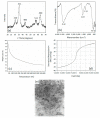Development and Evaluation of Crocetin-Functionalized Pegylated Magnetite Nanoparticles for Hepatocellular Carcinoma
- PMID: 37049645
- PMCID: PMC10095796
- DOI: 10.3390/molecules28072882
Development and Evaluation of Crocetin-Functionalized Pegylated Magnetite Nanoparticles for Hepatocellular Carcinoma
Abstract
Liver cancer remains among the leading causes of cancer-related deaths worldwide. This is due to many reasons, including limitations of available drugs, late diagnosis due to the overlapping symptoms with many other liver diseases, and lack of effective screening modalities. Compared to conventional chemotherapy, targeted drug delivery systems are advantageous in many ways, as they minimize drug resistance and improve therapeutic value for cancer patients. Nanomaterials, in general, and nanoparticles, in particular, possess nm size, which provides a high surface area for a great extent of functionalization to be used for the targeted delivery of cancer drugs. Amongst the different formulations of nanoparticles, magnetic nanoparticles (MNPs) have unique chemical and physical characteristics and magnetic behavior, making them preferable candidates as a core for drug delivery systems. To maintain the nanosized structure of MNPs, a polymeric coating is usually applied to maintain the nanoparticles dispersed in the solution. Moreover, the polymeric coating provides a plate form for carrying drug molecules on its surface. In the present study, poly(ethylene glycol) (PEG)-coated MNPs were successfully synthesized, where the optimum concentration of PEG on the surface of the MNPs was investigated. The PEG-coated MNPs were further coated with crocetin at different concentrations. The crocetin-coated pegylated MNPs were evaluated in vitro using a hepatic cell line (HepG2) for up to 72 h. Results showed good release kinetics under acidic and neutral conditions. The optimally prepared drug delivery system showed a high potential for reducing the HepG2 cell proliferation in vitro using an MTT assay. The calculated IC50 for Cro-PEG-MNPs were 0.1019, 0.0903, and 0.0462 mg/mL of 5×, 10× and 20×, respectively.
Keywords: PEG; crocetin; hepatocellular carcinoma; magnetite nanoparticles.
Conflict of interest statement
The authors declare no conflict of interest.
Figures










Similar articles
-
PLinaS-g-PEG coated magnetic nanoparticles as a contrast agent for hepatocellular carcinoma diagnosis.J Biomater Sci Polym Ed. 2020 Aug;31(12):1580-1603. doi: 10.1080/09205063.2020.1764183. Epub 2020 May 27. J Biomater Sci Polym Ed. 2020. PMID: 32460649
-
Folic acid-conjugated polyethylene glycol-coated magnetic nanoparticles for doxorubicin delivery in cancer chemotherapy: Preparation, characterization and cytotoxicity on HeLa cell line.Hum Exp Toxicol. 2017 Aug;36(8):833-845. doi: 10.1177/0960327116672910. Epub 2016 Oct 10. Hum Exp Toxicol. 2017. PMID: 27758842
-
Magnetite Nanoparticles and Spheres for Chemo- and Photothermal Therapy of Hepatocellular Carcinoma in vitro.Int J Nanomedicine. 2020 Oct 14;15:7923-7936. doi: 10.2147/IJN.S257142. eCollection 2020. Int J Nanomedicine. 2020. PMID: 33116509 Free PMC article.
-
Bioactivity of Hybrid Polymeric Magnetic Nanoparticles and Their Applications in Drug Delivery.Curr Pharm Des. 2016;22(22):3332-52. doi: 10.2174/1381612822666160208143237. Curr Pharm Des. 2016. PMID: 26853596 Review.
-
Magnetic Nanoparticles: New Perspectives in Drug Delivery.Curr Pharm Des. 2017;23(20):2908-2917. doi: 10.2174/1381612823666170215104659. Curr Pharm Des. 2017. PMID: 28215155 Review.
Cited by
-
Diosmin and Coenzyme q10: Synergistic histopathological and functional protection against doxorubicin-induced hepatorenal injury in rats.Toxicol Rep. 2024 Nov 30;13:101848. doi: 10.1016/j.toxrep.2024.101848. eCollection 2024 Dec. Toxicol Rep. 2024. PMID: 39703765 Free PMC article.
-
Recent Advances in Mesoporous Silica Nanoparticles Delivering siRNA for Cancer Treatment.Pharmaceutics. 2023 Oct 17;15(10):2483. doi: 10.3390/pharmaceutics15102483. Pharmaceutics. 2023. PMID: 37896243 Free PMC article. Review.
-
RGD peptide-functionalized micelles loaded with crocetin ameliorate doxorubicin-induced cardiotoxicity.Int J Pharm X. 2025 Feb 26;9:100326. doi: 10.1016/j.ijpx.2025.100326. eCollection 2025 Jun. Int J Pharm X. 2025. PMID: 40103672 Free PMC article.
-
Bioactive potency of extracts from Stylissa carteri and Amphimedon chloros with silver nanoparticles against cancer cell lines and pathogenic bacteria.Biomed Rep. 2024 Dec 19;22(2):34. doi: 10.3892/br.2024.1912. eCollection 2025 Feb. Biomed Rep. 2024. PMID: 39777210 Free PMC article.
-
Recent advances of novel targeted drug delivery systems based on natural medicine monomers against hepatocellular carcinoma.Heliyon. 2024 Jan 18;10(2):e24667. doi: 10.1016/j.heliyon.2024.e24667. eCollection 2024 Jan 30. Heliyon. 2024. PMID: 38312669 Free PMC article. Review.
References
-
- Limeres M.J., Moretton M.A., Bernabeu E., Chiappetta D.A., Cuestas M.L. Thinking small, doing big: Current success and future trends in drug delivery systems for improving cancer therapy with special focus on liver cancer. Mater. Sci. Eng. C. 2019;95:328–341. doi: 10.1016/j.msec.2018.11.001. - DOI - PubMed
MeSH terms
Substances
LinkOut - more resources
Full Text Sources
Medical

